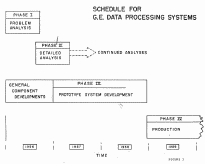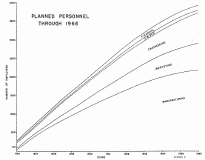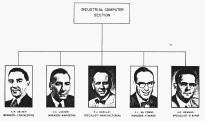|
Industrial Computer Section by H. R. OLDFIELD, JR.
Today we are going to concentrate on the subject of electronic data processing. I will not try to define the term "data processing", as it appears to mean all things to all men. Nevertheless, while our definitions may differ, I believe we all agree that presently available data processing equipment falls far short of meeting the present or contemplated requirements of the product departments of General Electric.
Existing equipment appears to be deficient in two respects. First there are the purely technical deficiencies such as: The slowness and inadequacy of present punched card-or tape input devices. The relative complexity or computer programming. The inadequacy of present logical design techniques. The high cost, size, and complexity of rapid access computer storage. And the like...
We can expect that the entire industry will push forward roughly in parallel in improving these various computer elements. It is doubtful if any one company can make sufficient breakthroughs in these technical area. to attain anything more than transient advantage over competition. We do feel that the strength of General Electric in the fields of solid state physics, magnetics, and pulse circuitry will put us in an excellent position to be highly competitive in the design and production of such building blocks; nevertheless they probably do not represent the major source of improvement at this time. The second major deficiency relates to the overall system philosophy of the data processing equipment, as differentiated from its physical execution. It is in this area where the greatest degree of controversy exists, both within and without General Electric. The arguments of general purpose versus special purpose versus multi-purpose and centralized versus decentralized equipment are raised in the case of practically every new application. It is an argument which cannot be settled without a profound understanding of the business in question hot just its procedures but also its philosophy of organization and operation. Without minimizing the perceptiveness of IBM and Sperry-Rand, we do feel that there are subtle patterns in General Electric which cannot be fully grasped from the outside. We consider that one major mission of the Industrial Computer Section over the next several years will be to obtain a detailed understanding of the real needs of our various Departments, and to develop and build data processing equipment which most nearly meets these Deeds. I refer here to all categories of data processing required for finance, engineering, manufacturing, marketing, and personnel from large multiple-purpose computers with several inputs to small special, purpose machines for such diverse applications as Operations Research, machine simulation, or the control of machine tools. In approaching this specific task we can, I think, point to certain advantages which the Industrial Computer Section possesses in relation to IBM and Sperry-Rand. First, as a part of General Electric, we presumably have access to details of our present and projected operation which you might not wish to give to individuals outside the Company. Second, by considering General Electric as a preferred customer, we can tailor equipment to your requirements in a way that IBM, for example, is unlikely to do. Actually, we do not feel that this tailoring process will restrict us in any way, as the equipment which meets the requirements of our average product department is likely to be adaptable to the requirements of the average medium size business. We visualize, therefore, a strong continuing market for such a product after the needs of our own Company are satisfied. In tackling this problem of creating data processing equipment fro General Electric? we are dividing our immediate efforts into the following three channels: First, we have already initiated a series of advanced development programs to improve our know-how and to develop useful techniques required for all important system. building blocks. You will hear more of this from Ken Geiser. Second, we are taking on contract jobs such as the ERMA program for the Bank of America, which permit us to develop standard components for immediate application to our own system. Third, we have organized a study team of representatives from marketing, engineering, and manufacturing, which has the job of determining the technical characteristics Of the basic data processing system which is best suited to the Deeds of the General Electric Company. While we realize that no two product departments have exactly the same problems, we feel that there are enough similarities to permit the specification of common building blocks? which? used in various combinations, can meet your needs. Our rough schedule for this program. is as fol1ows: (Figure 1)
Phase I consists of a problem analysis for a sufficient number and variety of departments to determine parameters which will make the system suitable to the majority of departments. It includes location and nature of data input and output stations, size and access time of memory units, rates of data flow, and so on. This work is now under way and is scheduled for completion in October, at which time we will have a product plan for the system as a whole. Figure 1
Figure 2 3.
Phase II consists of detailed analyses of individual elements of the system, culminating in a report of development work required, and PPA's and DA's on all e1ements of the system. We will begin issuing these in January of next year, and hope to complete them by April. Phase III, the development of the complete system, will be initiated on January 1, 1957, and we hope to complete the prototype for actual test in an operating department during 1958. Production deliveries can begin in 1959 if our customers desire. If our study team can establish a set of interim requirements, it is conceivable that we can, beat this schedule by as much as a year. Throughout all phases of this program we will Obviously work hand in glove with those services organizations and operating departments which are studying the data processing problems of the various departments. This includes donating systems engineering manpower to your studies where desired. In our own studies we will seek for technical similarities between engineering operations and accounting functions. We will relate special problems, such as those of G. E. Credit Corporation to those of the remainder of the Company. We will also seek out the basic differences as well as the similarities between different Company groups. Above all, we will attempt to specify that equipment which the various product departments feel they need to carry out their particular businesses in line with the Company's policy of decentralization. It is in this final phase of matching electronic data processing equipment to the Company's unique and powerful management philosophy that we hope to mate a real contribution to General Electric's progress. The main purpose of today's meeting is to accelerate the interchange of ideas necessary to permit us to gain an understanding of your problems. While we have a few preliminary concepts, and will discuss them later today, we feel that it is up to you to specify the data processing equipment you want. We have no pride of authorship, and will willingly act as tools to fashion the equipment you want and need to do your job. A second purpose of the meeting is lor ???s to tell you what we are now doing. what our present capabilities are as a computer -organization, and where we think we are heading over the next several years. We would lite you to leave the meeting with the feeling that we have the competence to design, develop, produce, and maintain the data processing equipment which will be discussed here today. As general background, a few statistics might be in order. The Industrial Computer Section will consist of about 250 people by the end of 1956. Figure 2 shows the planned growth of our organization through 1966. This growth pattern accelerates rapidly, beginning next year, to match the manufacturing and field service requirements of the ERMA project. This should put us in an excellent position, manpower-wise, to meet the requirements which we hope will be imposed on us by the rest of General Electric for data processing equipment. While our expansion is predicted on eventual success in obtaining your business, we will not delay our growth pending such 4. success. We realize that our objectives cannot be achieved with out risk, and we are prepared to take it~ We feel that we can achieve number three or four position in the industry by the 1960-1965 era. At that point we may not rival IBM or Sperry-Rand in total volume because we may not attempt to compete in large segments of the market which involve traditional general purpose machine equipment. However, as the product becomes increasingly electronic, our percentage of the available market should continue to increase, and, by 1965, we expect to be one of the acknowledged leaders in the computer field. We have been assured of the financing and management backing necessary to accomplish this aim. Because we are so new as an organization, it might be worthwhile to identify our functional managers. They include: (Figure 4) Ken Geiser, Manager - Engineering, formerly Manager of 'the Computer Section, General Engineering Laboratory. His engineering section now numbers 26 professional people, and is growing fast to meet the demands of our product plan. Clair Lasher, Manager - Marketing, formerly Manager of the Industrial Electronics Section of the Technical Products Department. Ray Barclay, Manufacturing Specialist, formerly Superintendent, Broadcast Equipment, Technical Products Department. Ken McCombs, Manager - Finance, who came to us from the Ontario, California Works, where he was Plant Accountant. Art Newman, E & P C R Specialist, formerly Specialist, Wage and Salary Administration, Technical Products Department. " We have outstanding people all down the line in our organization, and feel confident that we can continue to build tip at the rate required to meet our business forecast. A word about our planned product lines. We are not at present trying to cover the entire computer field but are aiming our "efforts toward certain major product categories. This includes the following: . First, industrial data processing, our primary product, representing half of our business, which is illustrated by such systems as ERMA and the proposed G. E. data processing system. For the time being we will keep away from the gigantic scientific computers which, of course, are included in this product category and will concentrate on developing complete systems to solve specific industrial and business problems. Figure 4 5.
Second, computers for process control including, in particular, directors for the control of machine tools. Third, analog computers and combined analog-digital computers for linear and Non-linear programming and the solution of varied engineering and management problems. Fourth, military computers of all types, both analog and digital. Much of our military work will be accomplished in support of the various military departments or General Electric. It will constitute about 20 per cent or our overal1 budget. We will attempt to pick projects which permit us to develop 'techniques applicable to our commercial product lines. Nevertheless, we will consider the Government business as an entity which must show a reasonable profit in its own right. This is a rather wide product spread, but we have arrived at it after a detailed study of the market and feel we can make a contribution in each area. Furthermore, there is an overlapping in engineering techniques which make most of these product lines mutual1y supporting. Even the military work is an important element of our plan, as it will keep us in the forefront of technological advances. Today, because of time limitations, we will discuss only those product lines which are immediately relevant to General Electric data processing problems. We will be glad to give you a detailed picture of our entire program at a later session. For the remainder of the meeting we intend to listen rather than talk. We have asked specialists in each functional area to state their requirements for data processing equipment and have carefully refrained from influencing their talks in any way, not that we could! Consequently, I am sure we will be exposed to a variety of interesting and provocative problems.
|
| BACK TO INDEX OF SPEECHES |



